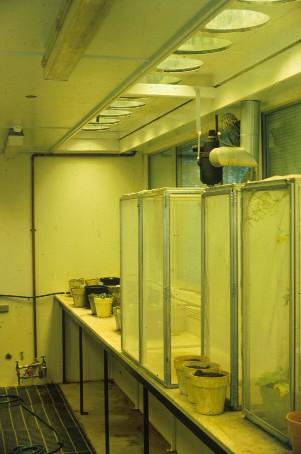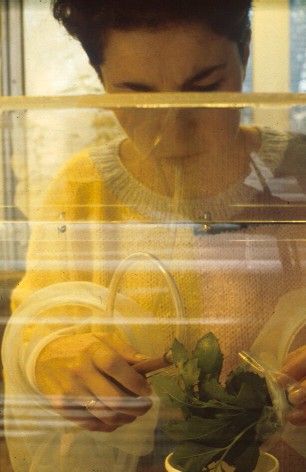Quarantine insectaries
|

Inside a quarantine insectary.

Working in quarantine conditions.
|
The FAO Code does not specify what is considered a
'secure quarantine'. Even in Australia, with its long history in weed
biological control, AQIS has only recently drawn up guidelines for
construction of quarantine insectaries for handling biological control
agents. Quarantine requirements vary according to the agents to be
handled, and considerably greater levels of security are needed for
pathogens with minute wind-blown spores than for comparatively large
insects. A higher level of security is also required if agents are to be
imported directly from field-collected material, which may contain
parasites and/ or diseases. Better standards are also necessary for
quarantines where host-testing is to be carried out, i.e. the agent is to
be reared for several generations in the quarantine, and, if found to be
unsafe, may be destroyed and never released
|
Basic requirements for a quarantine used to contain
imported agents from overseas are as follows:
 | Locked outer doors into an entry chamber. All
doors must have good seals; light should not be visible around
the door. The outer door should be locked and access restricted
to authorised staff.
|
 | An airlock with black internal walls between
the entry chamber and the quarantine proper. A light trap for
escaped insects should be set into an internal wall, using
natural light from the quarantine area.
|
 | A high security laboratory, with double-sealed
glass windows. Air conditioning must be protected by a fine
gauze mesh and by filters sufficient to remove fine dust
particles. These filters must be cleaned inside the quarantine
and the dust treated in the steriliser.
|
 | A sink with hot water inside the laboratory.
Water from this sink and the insectary should flow either to a
septic tank or soil trap, or to a tank which can be boiled or
treated with bleach when full. When the soil trap or septic is
cleaned, the contents must be sterilised before disposal.
|
 | A steam sterilising unit. Medical units which
use the normal power supply are readily available. An
incinerator can be used for plant and packaging material, but is
not really suitable for insects. If used, it is important to
ensure the heat is sufficient to destroy all the rubbish without
leaving some unburnt.
|
 | An area suitable for growing plants. This can
have a solid roof and glass windows and air-conditioning, in
which case artificial lights will be required for plant growth.
Or it can be a glasshouse or insectary, in which case all
ventilation must be covered with fine stainless steel or bronze
gauze or mesh with apertures small enough to prevent escape of
organisms held under quarantine. The glass roof must be
protected from hail and falling branches, and seals between
panes must be secure. Alternatively, the entire internal walls
and roof of the structure can be lined with fine metal mesh,
forming inner mesh walls and ceiling inside the glass. |
|
Procedures
The essential requirement for quarantine handling of
insect colonies is proper training for all staff. Escapes seldom happen
because of inadequate facilities, but through staff errors - leaving doors
open, throwing out waste without prior autoclaving or other treatment,
transferring plants from the quarantine glasshouse to another glasshouse
or plant-growing area. It is therefore essential that all staff be
properly trained in quarantine procedures. Access to the quarantine area
must then be strictly limited to trained staff who should arrange
their work schedules to limit the number of entries. Cleaning and routine
maintenance should be carried out by the quarantine staff. Access by
maintenance technicians should be kept to a minimum, and the technicians
involved should be informed of quarantine requirements and procedures.
Waste from all insect rearing activities (plant
cuttings, soil, cage debris, etc.) must be placed in clearly labelled bags
or bins. These bins must never be emptied without first being treated, in
the autoclave or other facility, and this rule must be rigidly enforced.
This can be assisted by use of hospital waste bags with a patch or strip
which changes colour when sterilised. Dustpans and brushes must be kept in
the quarantine for cleaning up, and never removed for use outside.
Laboratory equipment (plastic, glassware, etc.) should
be cleaned in hot water and detergent, and treated with a surface
sterilant such as bleach or alcohol. Spray bottles with alcohol are very
useful for immediate spot treatment of surfaces, and for killing unwanted
insects, parasites, etc. Paper towels for wiping up spills, drying
surfaces, etc. must be supplied. Cages should be treated with steam,
bleach or alcohol after being washed with water.
Plant material used for insect rearing in quarantine
should be fumigated or autoclaved before removing from quarantine. Pots
and potting mix should be fumigated before removal. |

